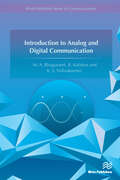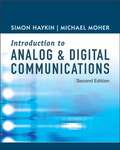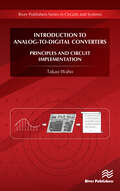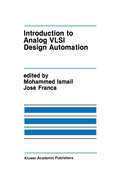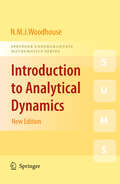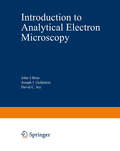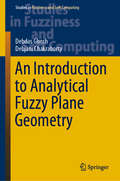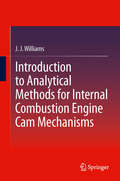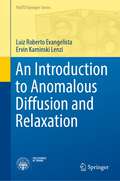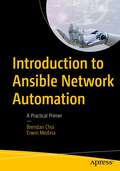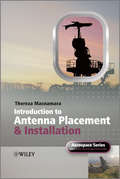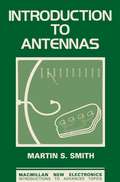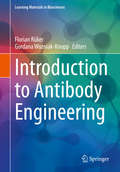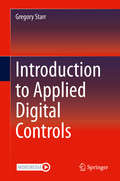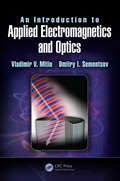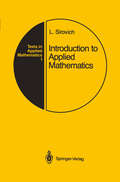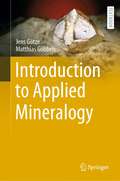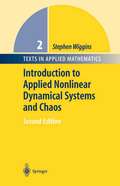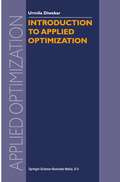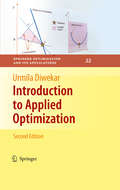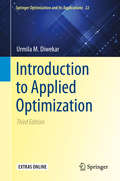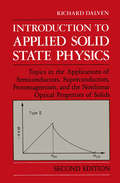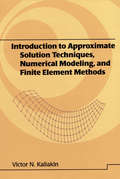- Table View
- List View
Introduction to Analog and Digital Communication
by M. A. Bhagyaveni R. Kalidoss K. S. VishvaksenanThis book primarily focuses on the design of analog and digital communication systems; and has been structured to cater to the second year engineering undergraduate students of Computer Science, Information Technology, Electrical Engineering and Electronics and Communication departments. For better understanding, the basics of analog communication systems are outlined before the digital communication systems section. The content of this book is also suitable for the students with little knowledge in communication systems. The book is divided into five modules for efficient presentation, and it provides numerous examples and illustrations for the detailed understanding of the subject, in a thorough manner.
An Introduction to Analog and Digital Communications
by Simon Haykin Michael MoherThe second edition of this accessible book provides readers with an introductory treatment of communication theory as applied to the transmission of information-bearing signals. While it covers analog communications, the emphasis is placed on digital technology. It begins by presenting the functional blocks that constitute the transmitter and receiver of a communication system. Readers will next learn about electrical noise and then progress to multiplexing and multiple access techniques.
Introduction to Analog-to-Digital Converters
by Takao WahoAnalog-to-digital (A/D) and digital-to-analog (D/A) converters, or data converters in short, play a critical role as interfaces between the real analog world and digital equipment. They are now indispensable in the field of sensor networks, internet of things (IoT), robots, and automatic driving vehicles, as well as high-precision instrumentation and wideband communication systems. As the world increasingly relies on digital information processing, the importance of data converters continues to increase.The primary purpose of this book is to explain the fundamentals of data converters for students and engineers involved in this fascinating field as a newcomer. The book will also help students who have learned the basics of analog circuit design to understand the state-of-the-art data converters. It is desirable for readers to be familiar with basic analog IC design and digital signal processing using z-transform.
Introduction to Analog-to-Digital Converters
by Takao WahoAnalog-to-digital (A/D) and digital-to-analog (D/A) converters, or data converters in short, play a critical role as interfaces between the real analog world and digital equipment. They are now indispensable in the field of sensor networks, internet of things (IoT), robots, and automatic driving vehicles, as well as high-precision instrumentation and wideband communication systems. As the world increasingly relies on digital information processing, the importance of data converters continues to increase.The primary purpose of this book is to explain the fundamentals of data converters for students and engineers involved in this fascinating field as a newcomer. The book will also help students who have learned the basics of analog circuit design to understand the state-of-the-art data converters. It is desirable for readers to be familiar with basic analog IC design and digital signal processing using z-transform.
Introduction to Analog VLSI Design Automation (The Springer International Series in Engineering and Computer Science #95)
by Mohammed Ismail José E. FrancaVery large scale integration (VLSI) technologies are now maturing with a current emphasis toward submicron structures and sophisticated applications combining digital as well as analog circuits on a single chip. Abundant examples are found on today's advanced systems for telecom munications, robotics, automotive electronics, image processing, intelli gent sensors, etc .. Exciting new applications are being unveiled in the field of neural computing where the massive use of analog/digital VLSI technologies will have a significant impact. To match such a fast technological trend towards single chip ana logi digital VLSI systems, researchers worldwide have long realized the vital need of producing advanced computer aided tools for designing both digital and analog circuits and systems for silicon integration. Ar chitecture and circuit compilation, device sizing and the layout genera tion are but a few familiar tasks on the world of digital integrated circuit design which can be efficiently accomplished by matured computer aided tools. In contrast, the art of tools for designing and producing analog or even analogi digital integrated circuits is quite primitive and still lack ing the industrial penetration and acceptance already achieved by digital counterparts. In fact, analog design is commonly perceived to be one of the most knowledge-intensive design tasks and analog circuits are still designed, largely by hand, by expert intimately familiar with nuances of the target application and integrated circuit fabrication process. The techniques needed to build good analog circuits seem to exist solely as expertise invested in individual designers.
Introduction to Analytical Dynamics (Springer Undergraduate Mathematics Series)
by Nicholas WoodhouseFirst published in 1987, this text offers concise but clear explanations and derivations to give readers a confident grasp of the chain of argument that leads from Newton’s laws through Lagrange’s equations and Hamilton’s principle, to Hamilton’s equations and canonical transformations. This new edition has been extensively revised and updated to include: A chapter on symplectic geometry and the geometric interpretation of some of the coordinate calculations. A more systematic treatment of the conections with the phase-plane analysis of ODEs; and an improved treatment of Euler angles. A greater emphasis on the links to special relativity and quantum theory showing how ideas from this classical subject link into contemporary areas of mathematics and theoretical physics. A wealth of examples show the subject in action and a range of exercises – with solutions – are provided to help test understanding.
Introduction to Analytical Electron Microscopy
by John HrenThe birth of analytical electron microscopy (AEM) is somewhat obscure. Was it the recognition of the power and the development of STEM that signaled its birth? Was AEM born with the attachment of a crystal spectrometer to an otherwise conventional TEM? Or was it born earlier with the first analysis of electron loss spectra? It's not likely that any of these developments alone would have been sufficient and there have been many others (microdiffraction, EDS, microbeam fabrication, etc.) that could equally lay claim to being critical to the establishment of true AEM. It is probably more accurate to simply ascribe the present rapid development to the obvious: a combination of ideas whose time has come. Perhaps it is difficult to trace the birth of AEM simply because it remains a point of contention to even define its true scope. For example, the topics in this book, even though very broad, are still far from a complete description of what many call AEM. When electron beams interact with a solid it is well-known that a bewildering number of possible interactions follow. Analytical electron microscopy attempts to take full qualitative and quantitative advantage of as many of these interactions as possible while still preserving the capability of high resolution imaging. Although we restrict ourselves here to electron transparent films, much of what is described applies to thick specimens as well. Not surprisingly, signals from all possible interactions cannot yet (and probably never will) be attained simultaneously under optimum conditions.
An Introduction to Analytical Fuzzy Plane Geometry (Studies in Fuzziness and Soft Computing #381)
by Debdas Ghosh Debjani ChakrabortyThis book offers a rigorous mathematical analysis of fuzzy geometrical ideas. It demonstrates the use of fuzzy points for interpreting an imprecise location and for representing an imprecise line by a fuzzy line. Further, it shows that a fuzzy circle can be used to represent a circle when its description is not known precisely, and that fuzzy conic sections can be used to describe imprecise conic sections. Moreover, it discusses fundamental notions on fuzzy geometry, including the concepts of fuzzy line segment and fuzzy distance, as well as key fuzzy operations, and includes several diagrams and numerical illustrations to make the topic more understandable. The book fills an important gap in the literature, providing the first comprehensive reference guide on the fuzzy mathematics of imprecise image subsets and imprecise geometrical objects. Mainly intended for researchers active in fuzzy optimization, it also includes chapters relevant for those working on fuzzy image processing and pattern recognition. Furthermore, it is a valuable resource for beginners interested in basic operations on fuzzy numbers, and can be used in university courses on fuzzy geometry, dealing with imprecise locations, imprecise lines, imprecise circles, and imprecise conic sections.
Introduction to Analytical Methods for Internal Combustion Engine Cam Mechanisms
by J J WilliamsModern design methods of Automotive Cam Design require the computation of a range of parameters. This book provides a logical sequence of steps for the derivation of the relevant equations from first principles, for the more widely used cam mechanisms. Although originally derived for use in high performance engines, this work is equally applicable to the design of mass produced automotive and other internal combustion engines. This work may also be applicable for cams used in other areas such as printing and packaging machinery. Introduction to Analytical Methods for Internal Combustion Engine Cam Mechanisms provides the equations necessary for the design of cam lift curves with an associated smooth acceleration curve. The equations are derived for the kinematics and kinetics of all the mechanisms considered, together with those for cam curvature and oil entrainment velocity. This permits the cam shape, all loads and contact stresses to be evaluated, and the relevant tribology to be assessed. The effects of asymmetry on the manufacture of cams for finger follower and offset translating curved followers is described, and methods for transformation of cam shape data to that for a radial translating follower are given. This permits the manufacture and inspection by a wider range of CNC machines. The calculation of unsteady camshaft torques is described and an outline given for evaluation of the components for the lower engine orders. Although the theory, use and design, of reactive pendulum dampers are well documented elsewhere, these subjects have also been considered for completeness. The final chapter presents analysis of push rod mechanisms, including a four bar chain mechanism, which is more robustWritten both as a reference for practising automotive design and development Engineers, and a text book for automotive engineering students, Introduction to Analytical Methods for Internal Combustion Engine Cam Mechanisms gives readers a thorough introduction into the design of automotive cam mechanisms, including much material not previously published.
An Introduction to Anomalous Diffusion and Relaxation (PoliTO Springer Series)
by Luiz Roberto Evangelista Ervin Kaminski LenziThis book provides a contemporary treatment of the problems related to anomalous diffusion and anomalous relaxation. It collects and promotes unprecedented applications dealing with diffusion problems and surface effects, adsorption-desorption phenomena, memory effects, reaction-diffusion equations, and relaxation in constrained structures of classical and quantum processes. The topics covered by the book are of current interest and comprehensive range, including concepts in diffusion and stochastic physics, random walks, and elements of fractional calculus. They are accompanied by a detailed exposition of the mathematical techniques intended to serve the reader as a tool to handle modern boundary value problems. This self-contained text can be used as a reference source for graduates and researchers working in applied mathematics, physics of complex systems and fluids, condensed matter physics, statistical physics, chemistry, chemical and electrical engineering, biology, and many others.
Introduction to Ansible Network Automation: A Practical Primer
by Brendan Choi Erwin MedinaThis book provides a comprehensive learning journey aimed at helping you master Ansible and efficiently automate a range of enterprise network devices, such as routers, switches, firewalls, Wireless LAN Controller (WLC), and Linux servers. Introduction to Ansible Network Automation combines the fundamentals of three books into one, covering basics of Linux administration, Ansible concepts, and Ansible network automation. Authors Brendan Choi and Erwin Medina have created a structured learning path that starts with the fundamentals and allows you to progressively enhance your skill sets with each chapter. Part I serves as an Ansible primer, guiding you through Linux basics using WSL on Windows 11 and assisting in the setup of your learning environment. Part II covers essential Ansible concepts through practical lab activities involving four Linux servers. In Part III, you will learn how to apply your Linux skills from Part I and the concepts from Part II to real-world scenarios by creating Ansible automation YAML scripts. What sets this book apart is its unique focus on Ansible and Network Automation, combined with a strong emphasis on understanding Linux. It is specifically designed for novice network automation engineers and students, assuming no prior Linux expertise, and provides first-hand experience starting from scratch. It also offers practical insights by sharing real-life examples of Ansible playbooks derived from production enterprise infrastructure, allowing you to gain an understanding of how Ansible can be effectively applied in real-world enterprise network environments. Upon completion of this book, you will have developed foundational skills in Ansible network automation and general Linux administration, and will understand how to apply this newly acquired knowledge to real-life scenarios. What You Will Learn Develop a comprehensive understanding of Ansible and its essential concepts for automating enterprise network devices and applying them to real-world scenariosMaster the basics of Ansible operations within Linux automation and progress to applying Ansible concepts specifically to network device automationExecute Ansible ad-hoc commands and playbooks for a range of network operational tasks, including configuration management, software and system updates, and upgradesWork with real-life examples of Ansible playbooks derived from actual enterprise infrastructure, gaining practical experience in writing Ansible YAML scriptsAcquire the skills to automate network operations using Ansible, streamline network management processes, and replace manual-driven tasks with directives in Ansible playbooks Who is This Book For Network, security, UC and systems engineers, as well as technical leaders, IT managers and network students.
Introduction to Antenna Placement and Installation (Aerospace Series)
by Thereza MacnamaraIntroduction to Antenna Placement and Installation introduces the characteristics of antennas and their integration on aircraft. The book covers antenna siting and placement, computational antenna modelling on structures, measurement on sub-scale models of the airframe, full-scale ground measurements and in-flight measurements. The author addresses the different stages in the process of developing an entire antenna layout, as well as covering individual retrofits on existing platforms. She explains the physics of antenna placement qualitatively, thus obviating the requirement to understand complex mathematical equations. Provides a reference book & guide written primarily for Antenna and Integration Engineers but which will also be of interest to Systems Engineers and Project Managers Includes chapters on aircraft systems using antennas, restrictions & trade-offs, frequency & spatial coverage considerations, effect of other antennas & obstacles, RF interoperability issues associated with radiated emissions, computer modelling software, scaled model & full-scale measurements, comparison between measurements & modelling, as well as ground tests and in-flight measurements Describes techniques that can be applied equally to antennas on other structures such as land or sea vehicles and spacecraft Illustrated throughout with figures & diagrams as well as a full colour plates
Introduction to Antibody Engineering (Learning Materials in Biosciences)
by Florian Rüker Gordana Wozniak-KnoppThis highly readable textbook serves as a concise and engaging primer to the emerging field of antibody engineering and its various applications. It introduces readers to the basic science and molecular structure of antibodies, and explores how to characterize and engineer them. Readers will find an overview of the latest methods in antibody identification, improvement and biochemical engineering. Furthermore, alternative antibody formats and bispecific antibodies are discussed.The book’s content is based on lectures for the specializations “Protein Engineering” and “Medical Biotechnology” within the Master’s curriculum in “Biotechnology.” The lectures have been held at the University of Natural Resources and Life Sciences, Vienna, in cooperation with the Medical University of Vienna, since 2012 and are continuously adapted to reflect the latest developments in the field. The book addresses Master- and PhD students in biotechnology, molecular biology and immunology, and all those who are interested in antibody engineering.
Introduction to Applied Digital Controls
by Gregory StarrThis textbook introduces senior undergraduate and beginning graduate students of mechanical engineering to the field of digital control with an emphasis on applications. Both transform-based and state-variable approaches are included, with a brief introduction to system identification. The material requires some understanding of the Laplace transform and assumes that the reader has studied linear feedback control systems. Adopting an accessible, “tutorial” format, the text presents a clear and concise treatment of Linear Difference Equations, Discrete Simulation of Continuous Systems, Sampled Data Systems, Design using Laplace and Z Transforms, Introduction to Continuous State Space, Digital Control Design using State Space Methods (including state estimators), and System Identification using Least Squares.
An Introduction to Applied Electromagnetics and Optics
by Vladimir V. Mitin Dmitry I. SementsovModern technology is rapidly developing and for this reason future engineers need to acquire advanced knowledge in science and technology, including electromagnetic phenomena. This book is a contemporary text of a one-semester course for junior electrical engineering students. It covers a broad spectrum of electromagnetic phenomena such as, surface waves, plasmas, photonic crystals, negative refraction as well as related materials including superconductors. In addition, the text brings together electromagnetism and optics as the majority of texts discuss electromagnetism disconnected from optics. In contrast, in this book both are discussed. Seven labs have been developed to accompany the material of the book.
An Introduction to Applied Electromagnetics and Optics
by Vladimir V. Mitin Dmitry I. SementsovModern technology is rapidly developing and for this reason future engineers need to acquire advanced knowledge in science and technology, including electromagnetic phenomena. This book is a contemporary text of a one-semester course for junior electrical engineering students. It covers a broad spectrum of electromagnetic phenomena such as, surface waves, plasmas, photonic crystals, negative refraction as well as related materials including superconductors. In addition, the text brings together electromagnetism and optics as the majority of texts discuss electromagnetism disconnected from optics. In contrast, in this book both are discussed. Seven labs have been developed to accompany the material of the book.
Introduction to Applied Mathematics (Texts in Applied Mathematics #1)
by Lawrence SirovichFrom the Preface: "The material in this book is based on notes for a course which I gave several times at Brown University. The target of the course was juniors and seniors majoring in applied mathematics, engineering and other sciences. My basic goal in the course was to teach standard methods, or what I regard as a basic "bag of tricks". In my opinion the material contained here, for the most part, does not depart widely from traditional subject matter. One such departure is the discussion of discrete linear systems. Besides being interesting in its own right, this topic is included because the treatment of such systems leads naturally to the use of discrete Fourier series, discrete Fourier transforms, and their extension, the Z-transform. On making the transition to continuous systems we derive their continuous analogues, viz., Fourier series, Fourier transforms, Fourier integrals and Laplace transforms. A main advantage to the approach taken is that a wide variety of techniques are seen to result from one or two very simple but central ideas. Above all, this course is intended as being one which gives the student a "can-do" frame of mind about mathematics. Students should be given confidence in using mathematics and not be made fearful of it. I have, therefore, forgone the theorem-proof format for a more informal style. Finally, a concerted effort was made to present an assortment of examples from diverse applications with the hope of attracting the interest of the student, and an equally dedicated effort was made to be kind to the reader."
Introduction to Applied Mineralogy
by Jens Götze Matthias GöbbelsThis textbook teaches important material and technological fundamentals in various technical systems and applied geoscientific fields. Beginning with the mineralogical characteristics of selected non-metallic raw materials and industrial minerals, this book presents the connections between properties and industrial applications and discusses the environment-relevant aspects as well as problems of biomineralogy. An introduction is given to important mineralogical and physico-chemical aspects of ceramic materials such as silicate ceramics, glass, cement, refractory materials as well as an overview about material synthesis.This makes it the first textbook to present the fundamentals of applied mineralogy as a material-related geoscience in a compact form and to show important bridges to industrial issues and approaches to solutions. It is aimed primarily at undergraduate students of geosciences and materials science, but is also suitable for related disciplines and practical applications.
Introduction to Applied Nonlinear Dynamical Systems and Chaos (Texts in Applied Mathematics #2)
by Stephen WigginsThis introduction to applied nonlinear dynamics and chaos places emphasis on teaching the techniques and ideas that will enable students to take specific dynamical systems and obtain some quantitative information about their behavior. The new edition has been updated and extended throughout, and contains a detailed glossary of terms. From the reviews: "Will serve as one of the most eminent introductions to the geometric theory of dynamical systems." --Monatshefte für Mathematik
Introduction to Applied Optimization (Applied Optimization #80)
by Urmila DiwekarThis text presents a multi-disciplined view of optimization, providing students and researchers with a thorough examination of algorithms, methods, and tools from diverse areas of optimization without introducing excessive theoretical detail. This second edition includes additional topics, including global optimization and a real-world case study using important concepts from each chapter. Introduction to Applied Optimization is intended for advanced undergraduate and graduate students and will benefit scientists from diverse areas, including engineers.
Introduction to Applied Optimization (Springer Optimization and Its Applications #22)
by Urmila DiwekarProvides well-written self-contained chapters, including problem sets and exercises, making it ideal for the classroom setting; Introduces applied optimization to the hazardous waste blending problem; Explores linear programming, nonlinear programming, discrete optimization, global optimization, optimization under uncertainty, multi-objective optimization, optimal control and stochastic optimal control; Includes an extensive bibliography at the end of each chapter and an index; GAMS files of case studies for Chapters 2, 3, 4, 5, and 7 are linked to http://www.springer.com/math/book/978-0-387-76634-8; Solutions manual available upon adoptions.
Introduction to Applied Optimization (Springer Optimization and Its Applications #22)
by Urmila M. DiwekarProvides well-written self-contained chapters, including problem sets and exercises, making it ideal for the classroom setting; Introduces applied optimization to the hazardous waste blending problem; Explores linear programming, nonlinear programming, discrete optimization, global optimization, optimization under uncertainty, multi-objective optimization, optimal control and stochastic optimal control; Includes an extensive bibliography at the end of each chapter and an index; GAMS files of case studies for Chapters 2, 3, 4, 5, and 7 are linked to http://www.springer.com/math/book/978-0-387-76634-8; Solutions manual available upon adoptions.
Introduction to Applied Solid State Physics: Topics in the Applications of Semiconductors, Superconductors, Ferromagnetism, and the Nonlinear Optical Properties of Solids
by R. DalvenIn addition to the topics discussed in the First Edition, this Second Edition contains introductory treatments of superconducting materials and of ferromagnetism. I think the book is now more balanced because it is divided perhaps 60% - 40% between devices (of all kinds) and materials (of all kinds). For the physicist interested in solid state applications, I suggest that this ratio is reasonable. I have also rewritten a number of sections in the interest of (hopefully) increased clarity. The aims remain those stated in the Preface to the First Edition; the book is a survey of the physics of a number of solid state devices and ma terials. Since my object is a discussion of the basic ideas in a number of fields, I have not tried to present the "state of the art," especially in semi conductor devices. Applied solid state physics is too vast and rapidly changing to cover completely, and there are many references available to recent developments. For these reasons, I have not treated a number of interesting areas. Among the lacunae are superiattices, heterostructures, compound semiconductor devices, ballistic transistors, integrated optics, and light wave communications. (Suggested references to those subjects are given in an appendix. ) I have tried to cover some of the recent revolutionary developments in superconducting materials.
Introduction to Approximate Solution Techniques, Numerical Modeling, and Finite Element Methods (Civil and Environmental Engineering)
by Victor N. KaliakinFunctions as a self-study guide for engineers and as a textbook for nonengineering students and engineering students, emphasizing generic forms of differential equations, applying approximate solution techniques to examples, and progressing to specific physical problems in modular, self-contained chapters that integrate into the text or can stand alone!This reference/text focuses on classical approximate solution techniques such as the finite difference method, the method of weighted residuals, and variation methods, culminating in an introduction to the finite element method (FEM). Discusses the general notion of approximate solutions and associated errors! With 1500 equations and more than 750 references, drawings, and tables, Introduction to Approximate Solution Techniques, Numerical Modeling, and Finite Element Methods:Describes the approximate solution of ordinary and partial differential equations using the finite difference method Covers the method of weighted residuals, including specific weighting and trial functions Considers variational methods Highlights all aspects associated with the formulation of finite element equations Outlines meshing of the solution domain, nodal specifications, solution of global equations, solution refinement, and assessment of resultsContaining appendices that present concise overviews of topics and serve as rudimentary tutorials for professionals and students without a background in computational mechanics, Introduction to Approximate Solution Techniques, Numerical Modeling, and Finite Element Methods is a blue-chip reference for civil, mechanical, structural, aerospace, and industrial engineers, and a practical text for upper-level undergraduate and graduate students studying approximate solution techniques and the FEM.
